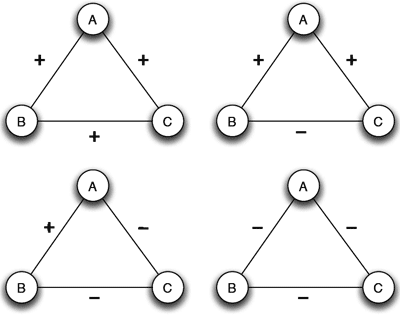Mathematical model shows how groups split into factions
By Bill Steele

The school dance committee is split; one group wants an "Alice in Wonderland" theme; the other insists on "Vampire Jamboree." Mathematics could have predicted it.
Social scientists have long argued that when under stress, social networks either end up all agreeing or splitting into two opposing factions. Either condition is referred to as "structural balance."
New Cornell research has generated a mathematical description of how this evolves. Previous mathematical approaches to structural balance have proven that when conditions are right, the result of group conflict will be a split into just two groups, the researchers said. The new work shows for the first time the steps through which friendships and rivalries shift over time and who ends up on each side.

"Structural balance theory applies in situations where there's a lot of social stress -- gossip disparaging to one person, countries feeling pressure, companies competing -- where we need to make alliances and find our friends and enemies," said Cornell Ph.D. candidate Seth Marvel, lead author of a paper explaining the research published during the week of Jan. 3, 2011, in the online edition of the Proceedings of the National Academy of Sciences with co-authors Jon Kleinberg, the Tisch University Professor of Computer Science, Robert Kleinberg, assistant professor of computer science, and Steven Strogatz, the Jacob Gould Schurman Professor of Applied Mathematics.
People may form alliances based on shared values, or may consider the social consequences of allying with a particular person, Marvel said. "The model shows that the latter is sufficient to divide a group into two factions," he said.
The model is a simple differential equation applied to a matrix, or grid of numbers, that can represent relationships between people, nations or corporations. The researchers tested their model on a classic sociological study of a karate club that split into two groups and got results that matched what happened in real life. They plugged in data on international relations prior to World War II and got almost perfect predictions on how the Axis and Allied alliances formed.
The smallest unit in such a network is a "relationship triangle," between, say, Bob and Carol and Ted, which can have four states:
"Every choice has consequences for other triangles," Strogatz explained, so unbalanced triangles kick off changes that propagate through the entire system. Too often the final state consists of two groups, each with all positive connections among themselves and all negative connections with members of the opposite group.
Is there a way to avoid the mathematical certainty of a split, perhaps to make Republicans and Democrats in Congress less polarized? It depends on the initial conditions, Marvel said. The model shows that if the "mean friendliness" -- the average strength of connections across the entire network is positive, the system evolves to a single, all-positive pattern. "The model shows how to influence the result, but it doesn't tell you how to get there," Kleinberg cautioned.
Marvel plans to test the model on other social networks, and perhaps work with psychologists to do lab experiments with human subjects. But he too cautions against leaning too heavily on the equations for practical advice. "This is a simple model and deterministic, and people aren't deterministic," he said.
The research was supported in part by the John D. and Catherine T. MacArthur Foundation, Google, the Yahoo! Research Alliance, a Microsoft Research New Faculty Fellowship, the Air Force Office of Scientific Research and the National Science Foundation.
Media Contact
Get Cornell news delivered right to your inbox.
Subscribe